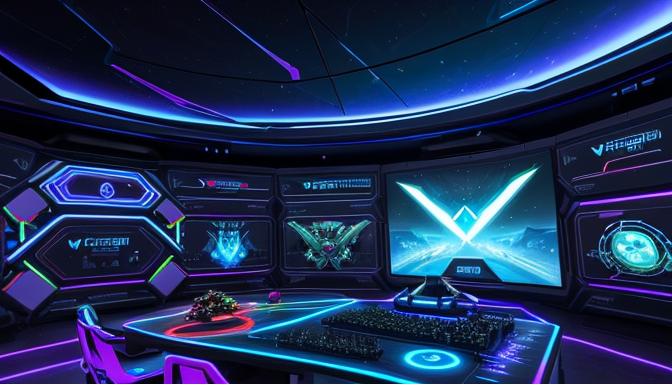Entertainment has undergone a remarkable transformation over the years, evolving from traditional forms like concerts and theater to the dynamic landscape we see today. Remember when a night out meant dressing up for a live show or heading to the cinema? Now, with just a few clicks, we can access a world of entertainment right from our couches. It’s like having a whole universe of stories, music, and experiences at our fingertips!
As we look ahead, the future of entertainment is brimming with possibilities. Imagine immersive concerts where you can feel the bass reverberate through your body, or theater performances that transport you to another world, all enhanced by cutting-edge technology. Festivals and pop-up shows are also taking on new dimensions, blending the physical and digital realms to create unforgettable experiences. In the USA, from the bustling streets of New York to the sunny beaches of California, the cultural scene is thriving with innovative events that cater to every taste.
So, what’s next? With trends pointing towards interactive and personalized experiences, it’s clear that we are on the brink of a new era. Audiences are no longer passive consumers; they want to engage, participate, and even influence the content they love. This shift is not just a trend; it’s a revolution that promises to redefine how we connect with entertainment in the years to come.
The Rise of Streaming Services
Streaming services have truly revolutionized the way we consume entertainment, transforming our viewing habits and reshaping the entire media landscape. Gone are the days when we relied solely on cable TV or physical media; now, we can access a vast library of content from the comfort of our homes. Isn’t it amazing how, with just a few clicks, we can dive into a world of movies, TV shows, and documentaries? This shift has not only changed our consumption patterns but has also had a profound impact on traditional media outlets.
Take a moment to consider the implications of this change: subscription models have emerged as a dominant force, allowing users to pay a monthly fee for unlimited access to their favorite content. With platforms like Netflix, Hulu, and Disney+, the demand for original programming has skyrocketed. These services are not just about streaming old classics; they are investing heavily in new, exclusive content that keeps viewers coming back for more. The competition is fierce, and as a result, we are witnessing an explosion of creativity and innovation in storytelling.
Moreover, the accessibility of streaming services has made it easier for audiences to follow the best entertainment and cultural events happening across the USA. From concerts and theater performances to festivals and pop-up shows, streaming platforms are evolving to include live events, making it possible for fans to experience these moments in real-time, no matter where they are. This combination of convenience and variety is what keeps us glued to our screens, eagerly awaiting the next big release!

The Future of Interactive Entertainment
As we dive into the future of interactive entertainment, it’s clear that we are on the brink of an exhilarating transformation. Imagine a world where your favorite games, concerts, and even theater performances are not just something you watch, but experiences you can actively participate in! With the rise of technologies like virtual reality (VR) and augmented reality (AR), the boundaries between reality and the digital realm are blurring faster than ever. Have you ever thought about how cool it would be to step into a concert where you are not just a spectator but part of the performance? This is the kind of future we are heading towards.
Emerging technologies are reshaping our engagement with entertainment. For instance, VR headsets are allowing users to immerse themselves in fantastical worlds, while AR apps enhance live events by overlaying digital elements onto the physical environment. This means that whether you are at a live concert or a theater show, the experience can be enhanced with interactive elements that respond to your actions. It’s like being in a choose-your-own-adventure story where every decision you make alters the outcome!
Furthermore, the demand for interactive experiences is skyrocketing. Audiences are no longer satisfied with passive consumption; they crave engagement and personalization. Here are a few trends that are shaping this exciting landscape:
- Gamification: Integrating game-like elements into live events to boost audience participation.
- Social Interaction: Platforms that allow fans to connect and interact during events, enhancing the communal experience.
- Customizable Content: Tailoring experiences to individual preferences, making entertainment more personal.
As we look ahead, it’s evident that the future of entertainment is not just about what we consume, but how we interact with it. So, buckle up! The next wave of entertainment is not just coming; it’s already here, and it’s set to explode in ways we can only begin to imagine!
Frequently Asked Questions
- What has driven the rise of streaming services?
The rise of streaming services can be attributed to the convenience they offer. Consumers now enjoy the flexibility of watching content anytime, anywhere, without the constraints of traditional broadcasting schedules. It’s like having a personal cinema in your pocket!
- How are streaming services changing traditional media?
Streaming services are reshaping traditional media by shifting audience preferences. Viewers are moving away from cable subscriptions towards on-demand content, leading to a decline in traditional TV viewership. This revolution is akin to switching from a horse-drawn carriage to a sleek electric car!
- What does the future hold for interactive entertainment?
The future of interactive entertainment looks bright, with advancements in gaming and virtual reality. These technologies are enhancing user engagement, making experiences more immersive. Imagine stepping into your favorite video game and truly becoming part of the action!
- Will original programming continue to grow?
Absolutely! The demand for original programming is skyrocketing as streaming platforms invest heavily in unique content. This trend is not just a fad; it’s becoming the new norm in entertainment consumption.